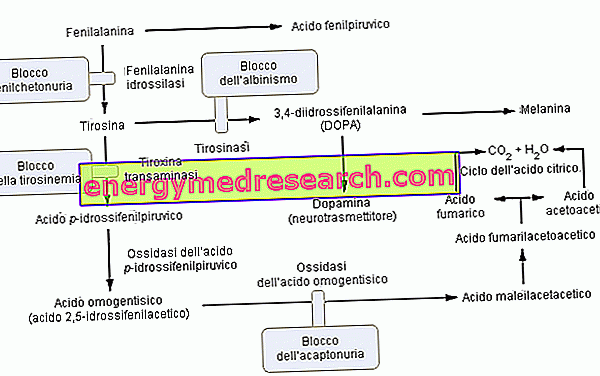
Stretch marks: how and why they are formed
The dermis is a connective tissue composed of a dense weave of fibers and a large quantity of cells immersed in the fundamental substance.
The fibers are mainly two:
- collagen fibers (fibrous glycoprotein): they are organized in bundles arranged between them according to a thick weave and very resistant to traction
- elastic fibers consisting of elastin microfibrils (also a fibrous glycoprotein) and fibrillin: they are less numerous and thinner than collagen fibers, they do not organize themselves into bundles, but branch and come together forming a lattice. Unlike collagen, they have remarkable elastic properties, in fact they are able to withstand even considerable tensions and twists, deforming and then returning to the original state of distension.
The amorphous substance (or fundamental substance) consists essentially of macromolecules of glucidic origin called glycosaminoglycans (GAG).

The skin with striae, compared to the "healthy" one, presents a non-compact dermal matrix. In fact, in the dermis not affected by striae, one can note the presence of a well-organized extracellular matrix containing collagen fibers, elastin fibers and microfibrils, while in the derma affected by striae, the matrix appears less compact, presents a greater content of fundamental substance and a reduced amount of collagen and elastin. In striae skin the components of elastic fibers are reduced and disorganized.
Stretch marks appear in the form of linear and fusiform lesions, with a trophic aspect, covered by a thin smooth or slightly pleated skin, sometimes depressed. They do not have hair follicles or sweat glands. The onset is in general asymptomatic, but may be accompanied by a slight sensation of itching or, more rarely, by burning and pain.
The formation of the stria distensae is determined in three phases:
- Inflammatory phase : lasts from a few months to 24 months, a period in which stretch marks generally extend slowly and take on a color ranging from pink to intense red. At the onset, a slight itching or burning may occur at the site of localization. In this initial phase their surface is normally smooth and they are characterized by red color caused by the increased flow of blood recalled by the mediators of inflammation; hence the name "striae rubrae". Fibroblasts, fundamental components of the dermis, reduce their proliferative activity and a chemical-physical modification of the fundamental substance takes place with consequent alteration of the elastic fibers and collagen. At the histological examination, the epidermis and the dermis appear thinned.
- Initial cicatricial phase : an atrophic process begins and the stria becomes thinner, pleated and takes on a pale pink color.
- Definitive cicatricial phase : the atrophic striae take on a white, mother-of-pearl or ivory appearance (striae alba). The collagen fibers have an irregular texture and appear loose, deformed, not grouped into bundles and often broken; the elastic fibers are fragmented or absent at the center of the lesion, while at the edges they appear curled and rolled up. The site of localization of the striae is free of sweat and sebaceous glands, hair follicles and melanocytes (in fact the striae, exposed to UV radiation, do not pigment themselves). Fibroblasts repair the injured area forming scar tissue that is poorly vascularized and consists exclusively of collagen fibers.
The striae are certainly more common in the white race, this does not avoid that even women of dark race are affected, indeed, their stretch marks may appear, as well as striae albae, also dark in color. While in striae albae already stabilized there is melanocytic damage with a reduction in both the number of melanocytes and melanogenesis, in dark people it can also happen that tissue distension, consequent to the decrease in the number of melanocytes, can reduce the mechanical-biological stimulus leading to a darkening of the streak.
Stretch Marks in Pregnancy
While striae gravidarum are observed with high frequency in white pregnant women, generally during the third trimester of gestation, on the contrary, Asian or African-American women are more difficultly affected by it. The area most affected is the abdomen, followed by the breast. After birth, the lesions tend to become clearer and less visible, but do not disappear completely.
The causes of stretch marks during pregnancy ( striae gravidarum ) are not yet certain. Likely, the risk factors related to the appearance of this blemish are:
- BMI (body mass index) and women's weight gain
- Age of the mother (the younger it is the higher the risk. Some scholars associate the frequent occurrence of severe striae gravidarum in young women due to the greater fragility, under the age of 20, of the glycoproteins responsible for the mechanical properties of resistance to stretching of skin and tissues)
- genetic predisposition (for example the type of elastic fibers)
- eating habits
- weight of the child at birth
- hormonal factors (presence of greater quantity of adrenocortical hormones, estrogens, relaxin in the circle of pregnant women)



